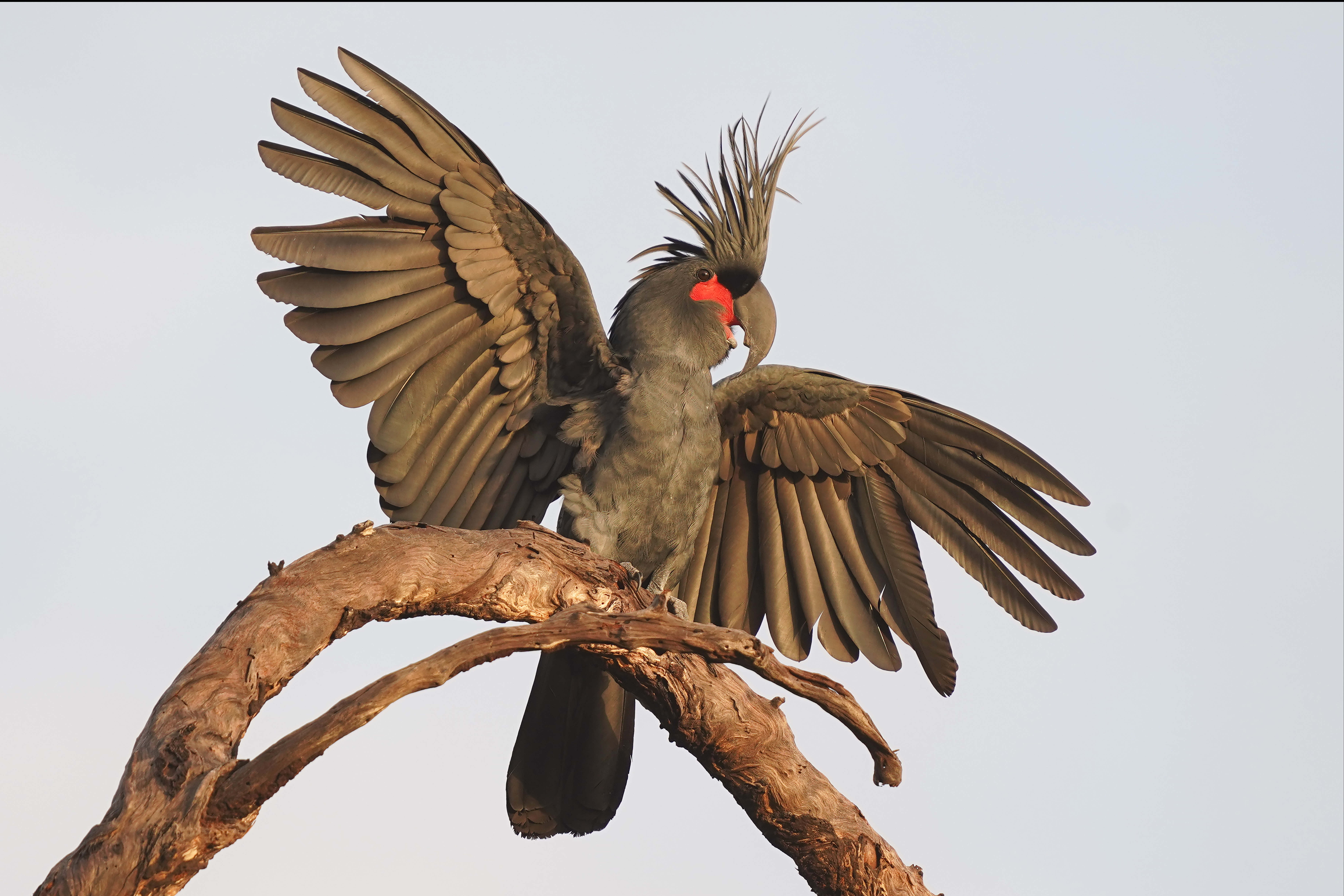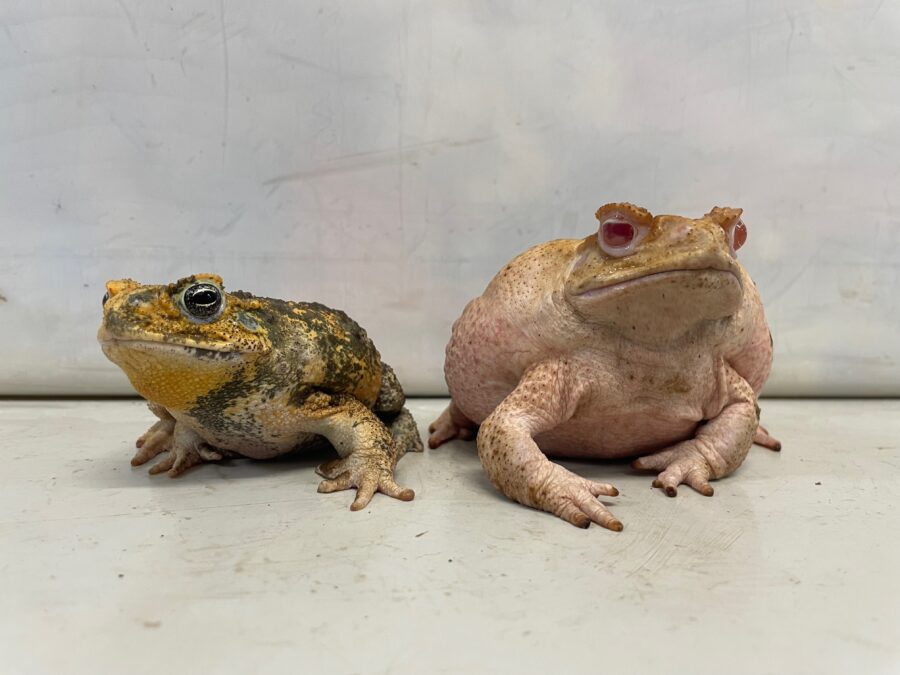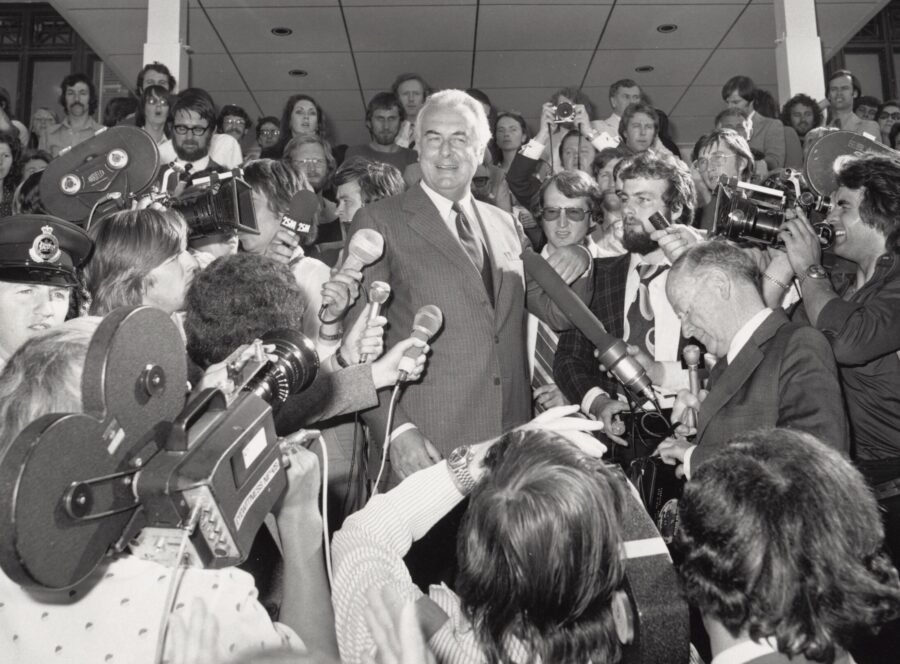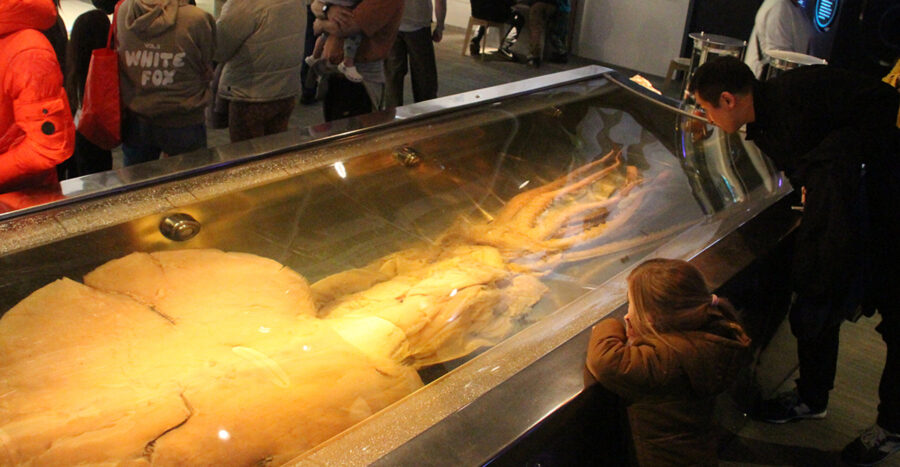In 2024 we were excited to launch the Australian Geographic Awards for Nature. This conservation funding program has significantly increased the Australian Geographic Society’s impact in tackling multiple threats to our embattled environment. At the same time, it has provided a valuable platform for conservationists to share their inspiring stories with much larger audiences than they could otherwise hope to reach.
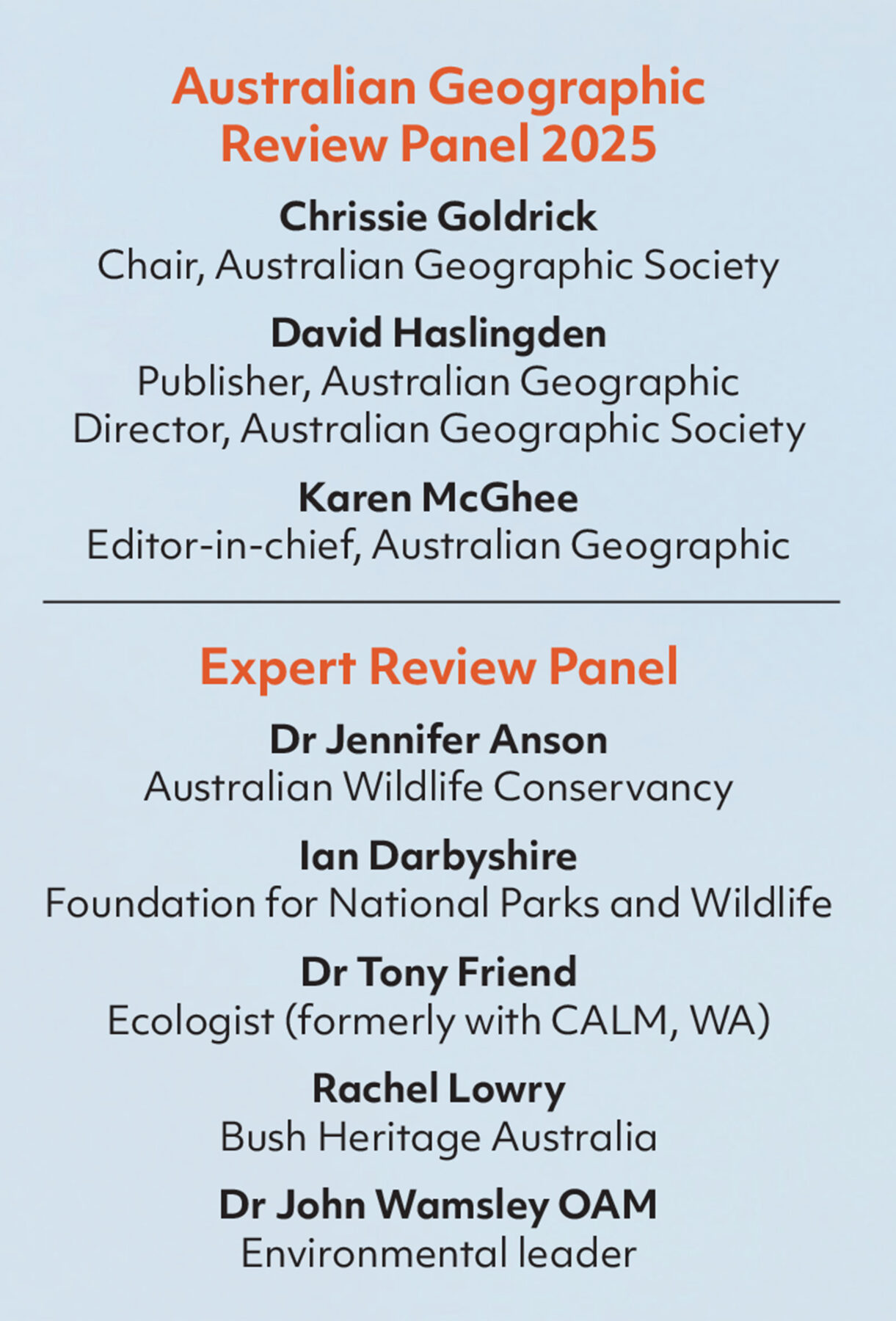
The awards are both an acknowledgement of past success and a vote of confidence in the future of the five award-winning projects that will share $150,000 in funding. Awards funds are generated from our ‘All Profits Donated to Nature’ business model, and we acknowledge our loyal magazine subscribers and customers for their support in making this possible.
We also thank everyone who applied. This program has uncovered so many wonderful and highly effective conservation efforts from across the nation led by smart, dedicated people. The final decisions were not reached lightly, and I would like to thank our expert review panel for their invaluable input.
From 71 expressions of interest received and 21 shortlisted, we’ve selected five projects for funding. They address key issues that align with the Society’s mission to protect against invasive species and biodiversity loss from threats including habitat destruction, climate change and marine ecosystem degradation. All projects have strong community involvement, including Indigenous leadership. They range across the country from Arnhem Land in the Top End to Eyre Peninsula in the south, and from rural Victoria to the tip of Cape York in Queensland.
The Society acknowledges the kind assistance of the Foundation for National Parks and Wildlife, with a particular shout-out to CEO Ian Darbyshire and grants coordinator Clementine Liebenberg for managing the online application process on our behalf. Also sincere thanks to museum director Kim McKay and the staff of the Australian Museum in Sydney for generously hosting the public presentation of the awards on 23 October 2025.
Gold Tier Award – $50,000
Project: Bug Hunt
Organisation: Invasive Species Council
When the final decision was made to give Bug Hunt our $50,000 Gold Tier funding award, it was met with instant and widespread approval. At last, a project tackling one of the most insidious threats to Australia’s biodiversity – the arrival of invasive invertebrates – was receiving the spotlight it deserves and support it desperately needs.
Australia has long battled the impact of invasive species. We hear plenty about feral cats, foxes and cane toads, but among the least-understood threats are tiny invertebrates. These creatures slip in through ports and airports and often go unnoticed until their populations have spread beyond control. Once established, they can devastate crops, unravel ecosystems and cost billions of dollars in control measures. Early detection is critical, yet the task of surveillance across a continent as vast as Australia is an enormous challenge.
That is, until now. The Invasive Species Council’s (ISC) Bug Hunt is rewriting biosecurity rules by enlisting the energy, curiosity and collective power of ordinary Aussies. It’s a bold citizen science program turning everyday encounters with insects and other invertebrates into vital data points in a national defence system. Whether you’re a gardener tending your backyard, a student peering into grass in the school playground, or a traveller curious about an unusual-looking bug at your campsite, your observation can help protect the nation’s biodiversity.
The concept is simple. Participants use the iNaturalist app on their smartphones to photograph and record invertebrate sightings. These are uploaded to the Atlas of Living Australia, the country’s most comprehensive biodiversity database. Each entry adds to the growing map of species distribution while experts scan the data for unusual or suspicious sightings. It’s a way of multiplying the eyes and ears of biosecurity authorities by thousands, without the need for costly new infrastructure.
The ISC has already proved that the idea works. During a pilot run in 2024, Bug Hunt generated more than 110,000 new invertebrate sighting records. For scientists, this represented an extraordinary leap in coverage and detail. “Every photo snapped is a gift to science and could be a lifeline for nature,” says Jack Gough, CEO of ISC. “With around 70 per cent of Australian invertebrates still unknown to western science, a single photo from a schoolyard could be the first record of a rare native species. Any of our citizen scientists could even be Australia’s next biosecurity hero, alerting authorities to an invasive ant or other invertebrate that has hitched a ride from overseas and could threaten our wildlife or agriculture.”
But Bug Hunt isn’t only about defence. It’s also a celebration. By drawing attention to bugs, it opens a window to a world of bedazzling diversity that’s too often overlooked. Australia is home to more than 250,000 invertebrate species, from the iridescent Christmas beetle to the industrious native carpenter bee, and each plays a role in keeping ecosystems healthy. Through Bug Hunt, these creatures will be framed not as creepy crawlies but essential parts of our natural environment.
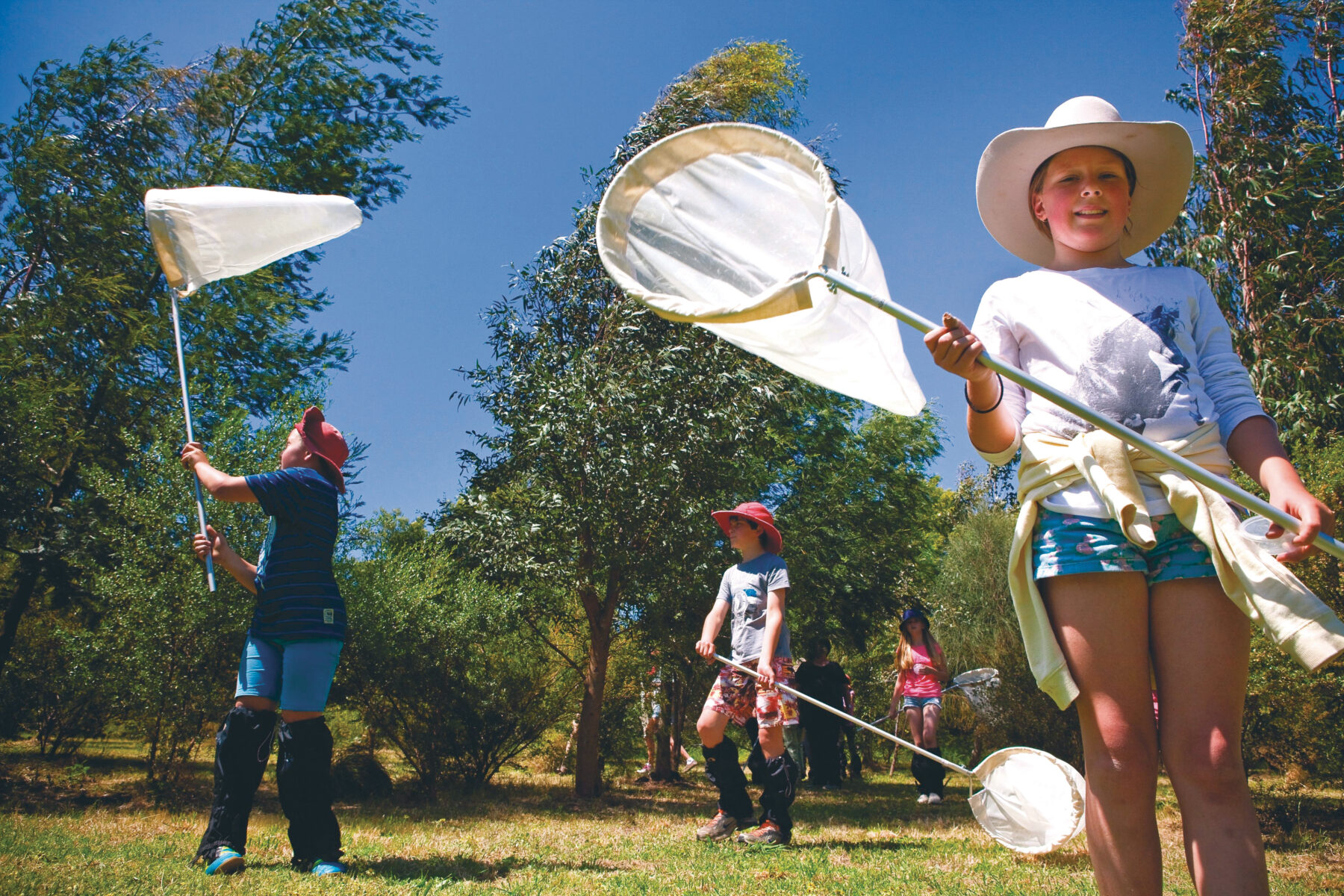
With the help of the AG Society’s $50,000 Gold Tier award, the project’s next phase will expand its impact through three major initiatives. First is Bugs in My Backyard Week, an annual event timed for late spring (17–23 November 2025) when insect life is at its busiest. Inspired by the popular Aussie Bird Count, it invites Australians to spend a week observing and reporting bugs. Whether it’s a balcony in the suburbs or a sheep station in the outback, the whole nation can become part of a great insect census.
Secondly, Bug Hunt is equipping teachers with curriculum-linked resources, prioritising schools near ports and airports where invasive pests are most likely to enter the country. Finally, Bug Hunt celebrates the ecological worth of native invertebrates, fostering fascination, not fear, and nurturing a deeper understanding of their role.
Backed by the federal Department of Agriculture, Fisheries and Forestry’s (DAFF) Environmental Biosecurity Project Fund and in collaboration with the experts at Invertebrates Australia, the program demonstrates the power of partnerships. The Australian Geographic Awards for Nature adds another layer, amplifying Bug Hunt’s mission not just through funds but also through storytelling, education and imagery.
In recognising Bug Hunt with our most prestigious award, we affirm that conservation is as much about participation as protection. Bug Hunt is more than surveillance; it’s a movement that empowers Australians to turn small moments of curiosity into data capable of defending entire ecosystems.
It’s a spirit that flows through every project honoured in this year’s awards.
Silver Tier Awards – $30,000
Project: C411 COUNTRY – Saving Faunal Emblems
Organisation: Nangana Landcare Network
The C411 COUNTRY plan is a transformative, landscape-scale initiative that aims to link fragmented habitats across 128,000ha of the Yarra Valley and Dandenong Ranges in Victoria. It’s coordinated by the Nangana Landcare Network to help save Victoria’s two faunal emblems: the critically endangered helmeted honeyeater (Lichenostomus melanops cassidix) and Leadbeater’s possum (Gymnobelideus leadbeateri). The figures are stark, and both species are perilously close to extinction. Fewer than 200 helmeted honeyeaters remain in the wild. For the lowland population of Leadbeater’s possums, the number is just 37. Reconnecting and expanding habitat at a scale that matches the enormity of the challenge is a must if these animals are to survive.
The $30,000 Silver Tier award will activate the Coranderrk Country stage of the C411 COUNTRY plan known as Saving Faunal Emblems. Coranderrk holds immense cultural significance for the Wurundjeri people. By aligning with the Burndap Birrarung burndap umarkoo: Yarra Strategic Plan, and being guided by the Wurundjeri Engagement Plan, the project will respect cultural authority and embed Traditional Owner values in the planning and implementation.
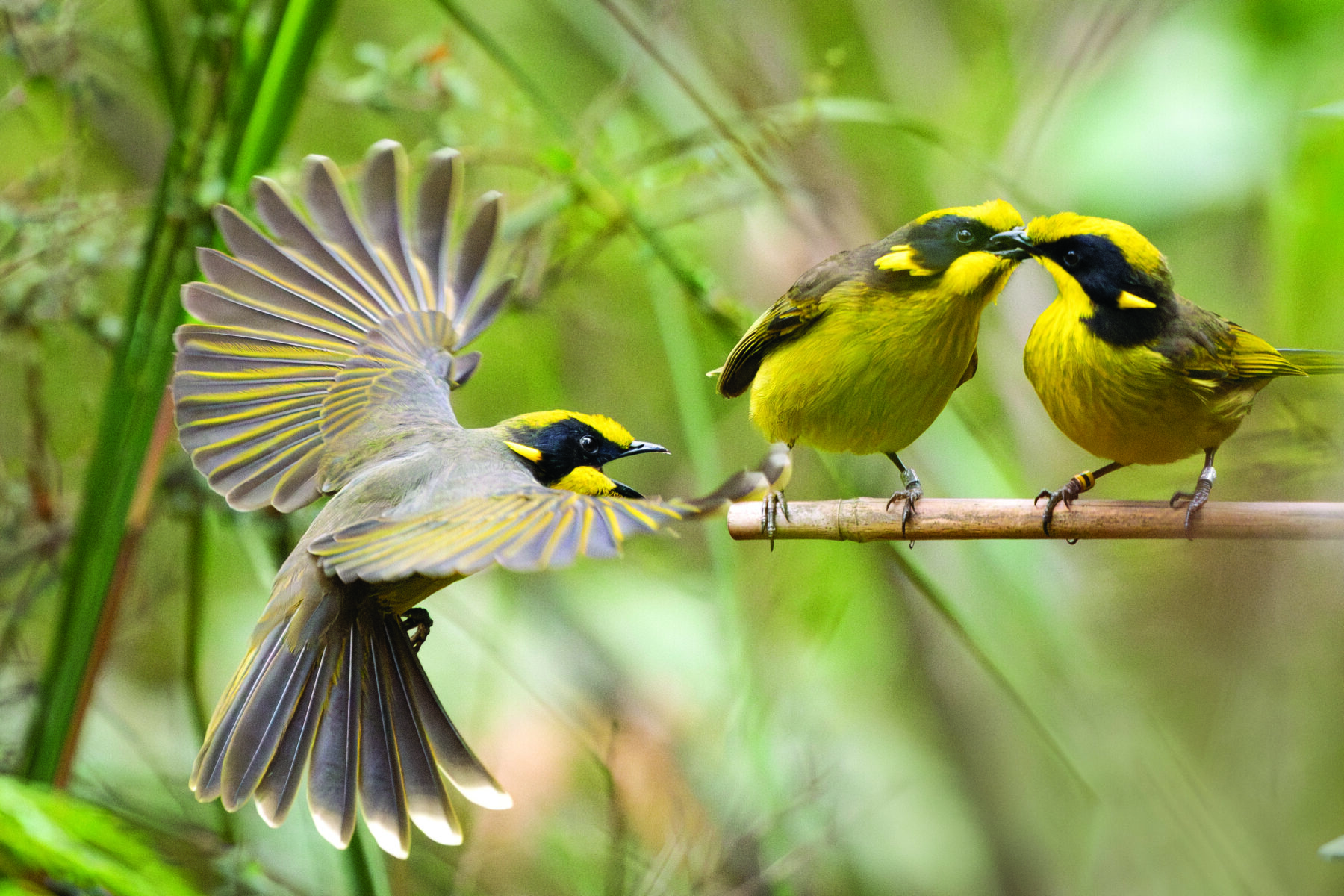
The Coranderrk Country team will engage 20 local landholders, empowering them to become active custodians of their land. It will identify and map more than 20ha of biodiversity corridors radiating from the Coranderrk Bushland Reserve and earmark them for restoration and long-term preservation. This will initiate a 20-year landscape recovery plan, grounded in the Conservation Standards for Healthy Country Planning and co-designed with the community, scientists and Traditional Owners.
It builds on the success of Beyond Yellingbo, a project that, since 2017, has restored 372ha across 121 private properties. This proved that coordinated, community-driven action can create meaningful habitat corridors and bring wildlife back into the landscape. Zoos Victoria ecologist Dr Dan Harley and landscape strategist Jeff Latter have estimated that a total of 128,000ha is needed for the long-term survival of Victoria’s precious faunal emblems.
“We need to build connecting corridors in the landscape for threatened species,” Jeff says. “More than that, it’s about connecting people with place. These funds allow us to do exactly that; engage private landholders directly in the conservation story. By equipping and supporting them, we are building a community-led model for landscape repair that will extend throughout all 128,000ha of C411 COUNTRY.”
Project: Warddeken Mayh Recovery Program
Organisation: Karrkad Kanjdji Trust and Warddeken Land Management Limited
Across much of the world, biodiversity loss is driven by urban development. In Australia, some of our most severe declines have occurred in the north across remote landscapes. In the Northern Territory, centralisation policies, which displaced First Nations communities from their ancient homelands, created what is described as ‘empty Country’ – land without people.
This disrupted traditional fire-management practices and accelerated the spread of invasive species. It also weakened the critical transfer of traditional ecological knowledge. The consequences lie ahead: of the 20 native Australian mammal species facing the highest risk of extinction in the next two decades, most are found in northern Australia.
In the rugged stone country of the Warddeken Indigenous Protected Area (IPA) in Arnhem Land, the main environmental threats come from herds of feral herbivores damaging sensitive habitats, late-season wildfires that destroy grasslands, and the scourge of feral cats. The Mayh Recovery Program, led by Warddeken Land Management Limited, has been responding to these threats since 2016. Combining Indigenous knowledge with western science, it empowers Warddeken rangers to restore fragile populations of threatened species. Its goals include strengthening conservation actions, ensuring cultural species are present in the landscape, and the passing on of knowledge between generations.
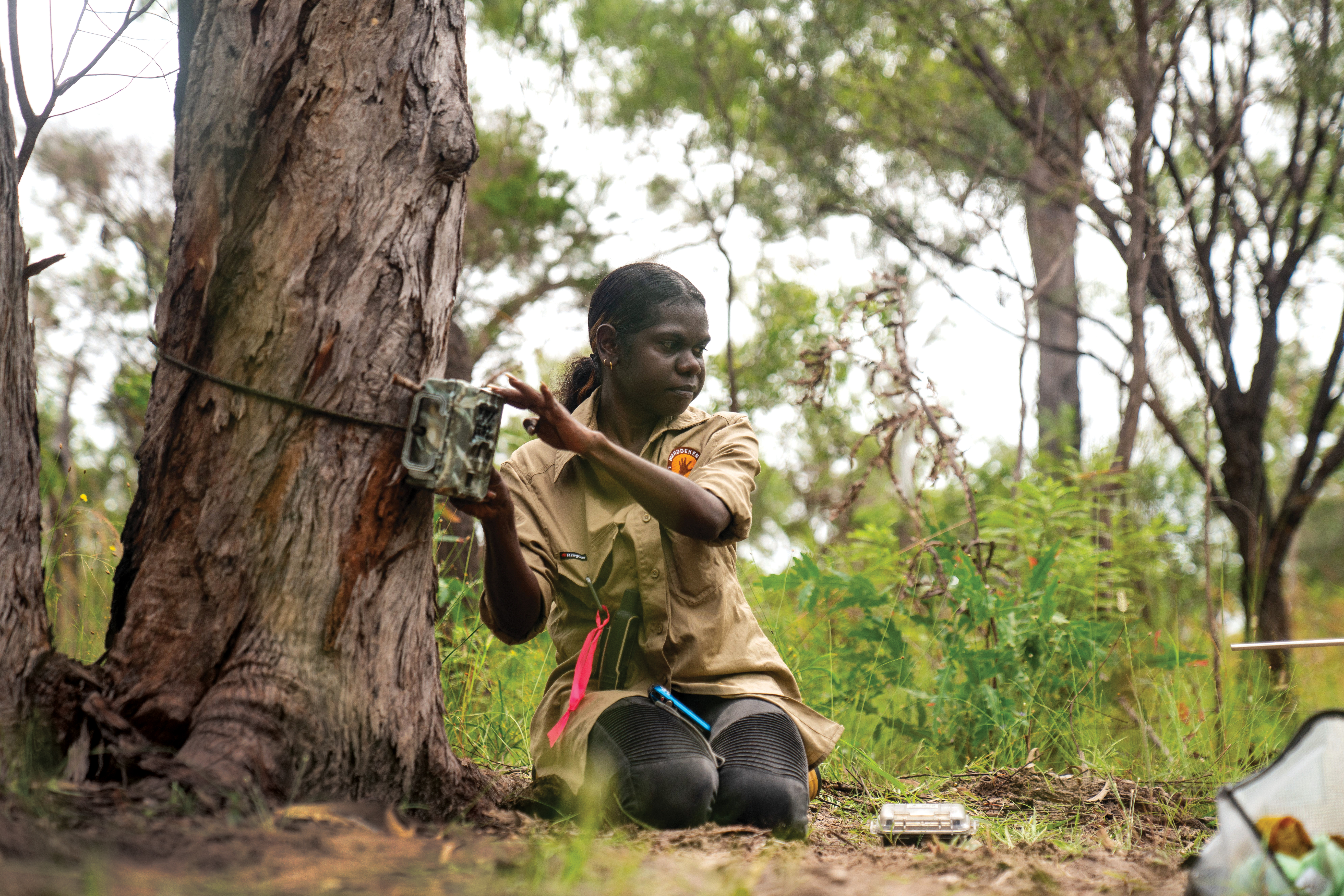
A growing monitoring network of motion sensor cameras and acoustic recorders has confirmed more than 10 threatened species of national significance present within the IPA’s 1.4 million hectares. This area encompasses some of the most ecologically and culturally significant landscapes in Australia, including ancient rock-art sites, endemic biodiversity and vital ecosystems. In fact, the Western Arnhem Plateau, which constitutes much of the IPA, is considered the NT’s most biodiverse area. Importantly, its remote and striking landscape is largely inaccessible by road, which makes it both a logistically and financially challenging region to manage and preserve.
Current strategies prioritise three species of cultural and ecological importance: the djabbo (northern quoll), djebuyh (northern brushtail possum), and yirlinkirrkirr (white-throated grass wren) – a bird that’s found nowhere else in the world.
The $30,000 Silver Tier funding will help support true boots-on-the-ground conservation actions – ranging from targeted burning to protect long unburnt habitat to artificial shelter deployment and feral herbivore control. Through this program, Bininj-led land stewardship is securing a future for Australia’s most endangered animals.
Bronze Tier Awards – $20,000
Project: Reviving Coffin Bay’s Lost Oyster Reefs
Organisation: The University of Adelaide and Eyrelab
University of Adelaide marine ecologist Dr Dominic McAfee has spent more than a decade restoring South Australia’s lost oyster reefs. He’s the lead on the project receiving our Bronze Tier award of $20,000, which had modest, community-based beginnings in Coffin Bay but has been dramatically accelerated by an unfolding environmental crisis. The devastating algal bloom that swept the state’s coast wiped out vast numbers of marine organisms. Yet oyster reefs, long recognised as ecological powerhouses, are proving remarkably resilient to the catastrophe.
“I’ve been diving on reefs we restored years ago and they’re still surviving in these intensely impacted areas,” Dominic says. “We were restoring reefs for biodiversity and fish productivity, but now they’re also showing resilience.”
That resilience has captured the attention of the SA Government. From a small citizen-science grant, this project has quickly escalated into a $1.8 million project to facilitate community-based reef restorations at 25 sites across the Eyre Peninsula, Yorke Peninsula and on Kangaroo Island. “It’s a very fast-moving situation,” Dominic says. “It’s big – very big.”
Scaling up means more than building reefs. Dominic’s small team, created through a partnership between The University of Adelaide and the not-for-profit Eyrelab, used to rely on part-timers. It can now bring on full-time staff and project managers and engage new PhD students. With the assistance of the Australian Geographic nature grant, a planned shell processing centre – essential infrastructure for preparing the vast volumes of oyster shell required – will finally be built. The centre will provide a hub where volunteers, school groups and local residents can contribute. “People are crying out for stewardship opportunities. The appetite is there,” Dominic says.
Two centuries ago, oyster reefs stretched for more than 7000km around Australia’s coastline, filtering seawater, providing fish habitat and cycling nutrients to the sea floor. By the late 19th century, dredge fishing had destroyed them. Today, most Australians are unaware these ecosystems ever existed. Without that knowledge, building support for large-scale restoration has been difficult.
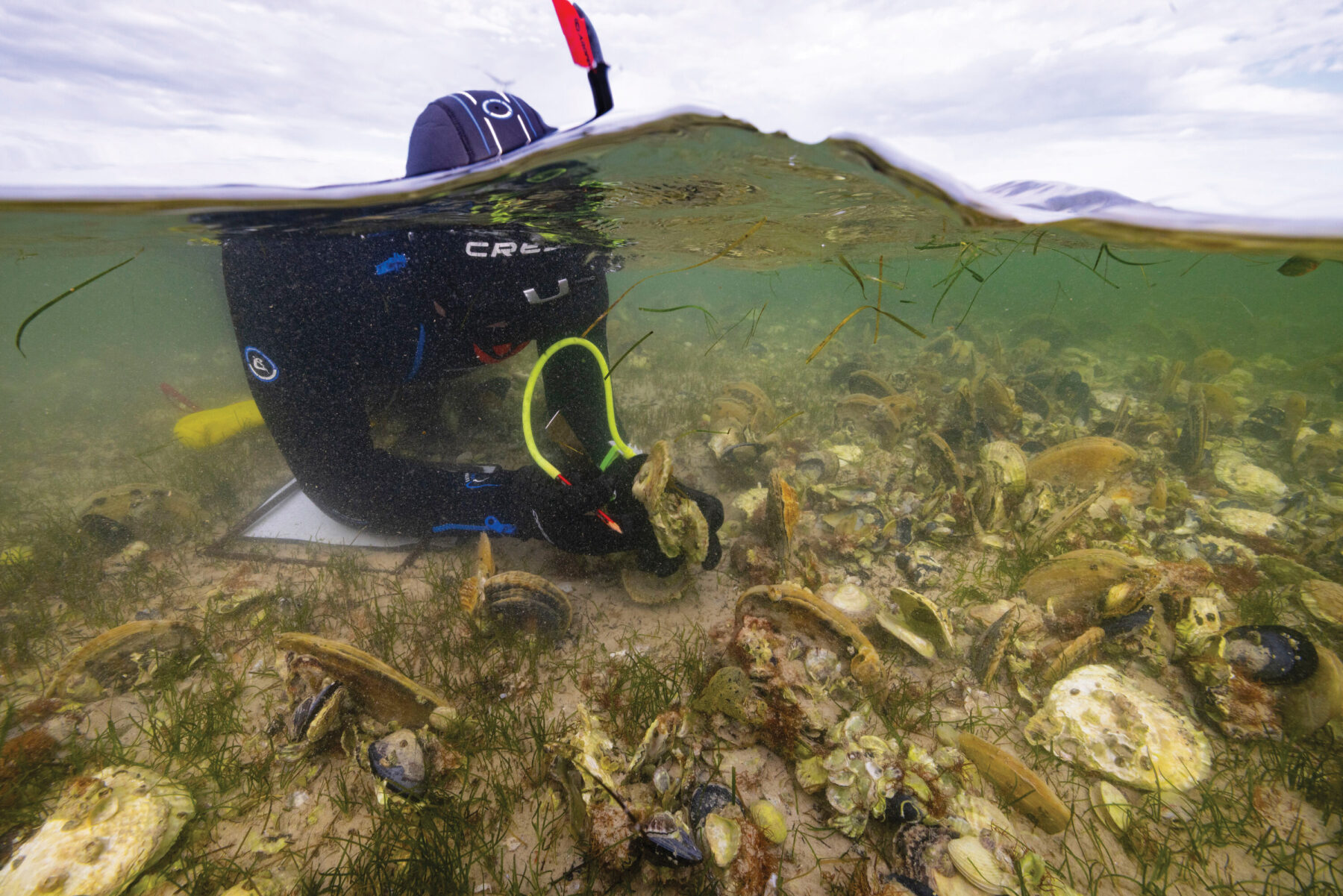
The Reviving Coffin Bay’s Lost Oyster Reefs project aims to change that. Its goals are to construct and monitor reefs, engage school students and the wider community, and build the ecological knowledge and infrastructure needed for future expansion. Already, biodegradable shell bags are being produced to construct reefs, and the new shell centre in Coffin Bay will help upscale the work. Students and community members monitor these reefs, while trained recreational divers gather biodiversity data using underwater survey methods.
The shell centre will become a hub for education and engagement. Community events and school programs there will encourage people to clean oyster shells, assemble reef bags and examine samples, while annual forums will share progress. Scientific monitoring will track oyster recruitment and biodiversity gains, creating the evidence base to guide the expansion that has arrived so rapidly in response to the unfolding environmental crisis.
By combining science, local knowledge and grassroots participation, this project is restoring not only a vital ecosystem but also the community’s connection to it. For Dominic, the rapid growth is overwhelming but welcome. “This project has overrun my life,” he admits. “But that’s fine because it’s the most important work I’ve done. It looks like it’s going to occupy me 100 per cent for the next few years.”
Project: The Palm Cockatoo Breeding Habitat Restoration Project
Organisation: People For Wildlife
The Apudthama landscape, on the tip of Cape York in Queensland, provides crucial breeding habitat for the palm cockatoo (Probosciger aterrimus). Growing to 65cm in length and a weight of up to 1.2kg, this is Australia’s largest parrot species. It’s believed fewer than 3000 wild individuals survive in Australia, although this data is outdated and more accurate population figures are urgently needed.
The decline in the species is linked to it having the lowest reported breeding success of any parrot, combined with a loss of suitable nesting hollows. Palm cockatoos, known as ‘palmies’, require hollows in centuries-old trees. These form only after centuries of natural processes involving termites, fungi, cyclones and rain. Old-growth trees large enough to host such hollows are now scarce, and are threatened by hot fires, invasive weeds and land-use changes. The result is a critical housing shortage for this charismatic species.
People For Wildlife is tackling this crisis by working with palm cockatoo expert Dr Christina Zdenek, the Apudthama Land and Sea Rangers, and specialist arborists to create and protect suitable nesting hollows. Methods include hollowing sections of large fallen trees and erecting them securely into old-growth canopies, as well as modifying existing hollows to meet palm cockatoo needs. Rangers also establish protective firebreaks around both natural and artificial hollows to reduce the risk of destruction by fire.
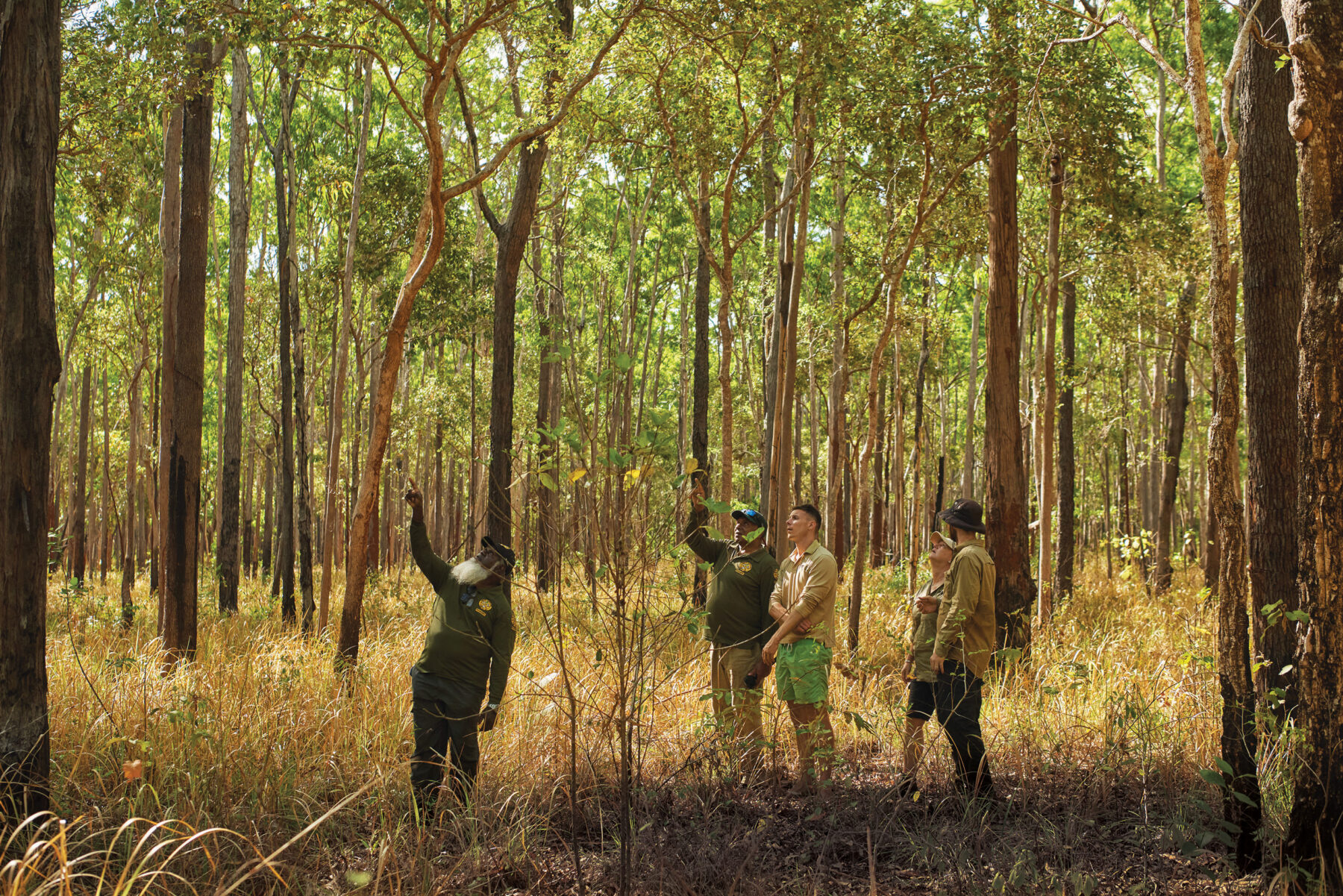
“In the nearly 20 years I’ve been working closely with this species I’ve come to realise that large tree hollows are everything for palmies. Their world revolves around them,” Christina says. “Without these big old hollows to breed in, palm cockatoos will go extinct. That’s why it’s devastating to observe a precipitous loss of these in the landscape. Not only palmies but also many other birds and mammals, and even snakes, rely on these keystone ecological structures for survival. That’s why I’m obsessed with old-growth tree-hollow protection and supplementation and why I’ve partnered with People For Wildlife to deliver this critical conservation project.”
Monitoring will be vital. Using wildlife cameras, passive acoustic recorders and field observations, the team will assess whether artificial hollows offer a long-term solution. Building on a successful 2024 pilot, and with the help of AG’s $20,000 Bronze Tier award, the goal is to double the number of known hollows by creating 28 new ones by mid-2027. At least 56 more firebreaks will also be created around trees known to contain hollows, hopefully securing a future for the iconic, beautiful palmie.
